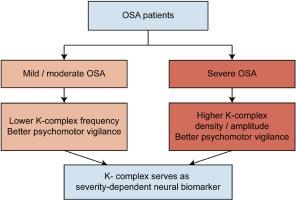K- complex metrics predict psychomotor vigilance in young and middle-aged adults with obstructive sleep apnea: A severity-dependent neural biomarker study
IF 3.4
2区 医学
Q1 CLINICAL NEUROLOGY
引用次数: 0
Abstract
Background
K-complexes, electroencephalographic markers of sleep protective mechanisms, may reflect cognitive impairment in obstructive sleep apnea (OSA). We investigated whether K-complex metrics (frequency, density, duration, amplitude) independently predict psychomotor vigilance in patients with OSA.
Methods
In 140 young and middle-aged adults, K-complexes were automatically detected via a U-Net neural network analyzing F3-M2 electroencephalogram recording. K-complex metrics, including frequency (Hz), density (events/min), duration (sec) and amplitude (μV), were measured. Psychomotor vigilance was assessed via standardized Psychomotor Vigilance Test (PVT). Hierarchical regression models evaluated associations between K-complex metrics and psychomotor vigilance, adjusted for age, education, and apnea-hypopnea index (AHI).
Results
K-complex metrics showed severity-dependent associations with psychomotor vigilance in young and middle-aged adults with OSA, meaning the nature of these associations predictably changed based on OSA severity. In patients with mild/moderate OSA, lower K-complex frequency (p = 0.011) was associated with better psychomotor vigilance. In patients with severe OSA, higher K-complex density (p = 0.019) and amplitude (p = 0.030) were independently associated with better psychomotor vigilance. K-complex metrics explained 15.2 % and 23.5 % additional variance in PVT Lapses in patients with mild/moderate and severe OSA, respectively. Age, education, and AHI further modulated psychomotor vigilance, particularly in patients with mild/moderate OSA.
Conclusions
K-complex density, frequency, and amplitude serve as severity-dependent neural biomarkers of psychomotor vigilance in young and middle-aged adults with OSA. These findings suggest the role of sleep metrics in psychomotor vigilance and highlight potential electrophysiological targets for intervention.

K-复合体指标预测中青年阻塞性睡眠呼吸暂停患者的精神运动警觉性:一项依赖于严重程度的神经生物标志物研究
背景-复合物是睡眠保护机制的脑电图标记物,可能反映阻塞性睡眠呼吸暂停(OSA)的认知障碍。我们研究了k复合体指标(频率、密度、持续时间、振幅)是否能独立预测OSA患者的精神运动性警觉性。方法采用U-Net神经网络分析140例中青年脑电图F3-M2记录,自动检测k复合物。测量频率(Hz)、密度(events/min)、持续时间(sec)和振幅(μV)等k -复指标。采用标准化精神运动警觉性测验(PVT)评估精神运动警觉性。分层回归模型评估k复合体指标与精神运动警觉性之间的关系,并根据年龄、教育程度和呼吸暂停低通气指数(AHI)进行调整。结果:sk复杂指标显示,在患有OSA的中青年成人中,精神运动警觉性与严重依赖性相关,这意味着这些关联的性质可预测地根据OSA严重程度发生变化。在轻度/中度OSA患者中,较低的k -复合体频率(p = 0.011)与较好的精神运动警觉性相关。在严重OSA患者中,较高的k复合体密度(p = 0.019)和振幅(p = 0.030)与较好的精神运动警觉性独立相关。k复合指标分别解释了轻/中度和重度OSA患者PVT缺失15.2%和23.5%的额外方差。年龄、教育程度和AHI进一步调节精神运动警觉性,特别是在轻度/中度OSA患者中。结论sk复合体密度、频率和振幅是影响中青年OSA患者精神运动警觉性的神经生物标志物。这些发现表明睡眠指标在精神运动警觉性中的作用,并强调了干预的潜在电生理目标。
本文章由计算机程序翻译,如有差异,请以英文原文为准。
求助全文
约1分钟内获得全文
求助全文
来源期刊

Sleep medicine
医学-临床神经学
CiteScore
8.40
自引率
6.20%
发文量
1060
审稿时长
49 days
期刊介绍:
Sleep Medicine aims to be a journal no one involved in clinical sleep medicine can do without.
A journal primarily focussing on the human aspects of sleep, integrating the various disciplines that are involved in sleep medicine: neurology, clinical neurophysiology, internal medicine (particularly pulmonology and cardiology), psychology, psychiatry, sleep technology, pediatrics, neurosurgery, otorhinolaryngology, and dentistry.
The journal publishes the following types of articles: Reviews (also intended as a way to bridge the gap between basic sleep research and clinical relevance); Original Research Articles; Full-length articles; Brief communications; Controversies; Case reports; Letters to the Editor; Journal search and commentaries; Book reviews; Meeting announcements; Listing of relevant organisations plus web sites.
 求助内容:
求助内容: 应助结果提醒方式:
应助结果提醒方式:


